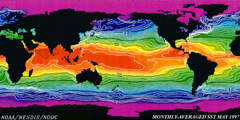


Similar term(s): El Niño-Southern Oscillation, ENSO.
El Niño, in its original sense, is a warm water current which periodically flows along the coast of Ecuador and Peru, disrupting the local fishery.
This oceanic event is associated with a fluctuation of the intertropical surface pressure pattern and circulation in the Indian and Pacific oceans, called the Southern Oscillation. This coupled atmosphere-ocean phenomenon is collectively known as El Niño-Southern Oscillation, or ENSO.
During an El Niño event, the prevailing trade winds weaken and the equatorial countercurrent strengthens, causing warm surface waters in the Indonesian area to flow eastward to overlie the cold waters of the Peru current.
This event has great impact on the wind, sea surface temperature and precipitation patterns in the tropical Pacific. It has climatic effects throughout the Pacific region and in many other parts of the world.
The opposite of an El Niño event is called La Niña.

Español: El Niño
Français: El Niño